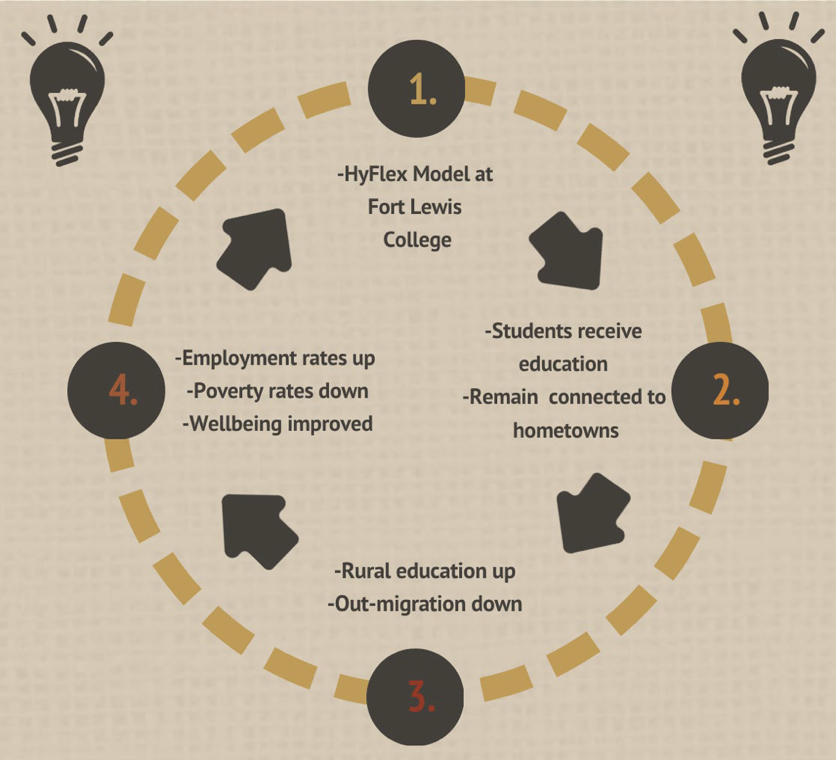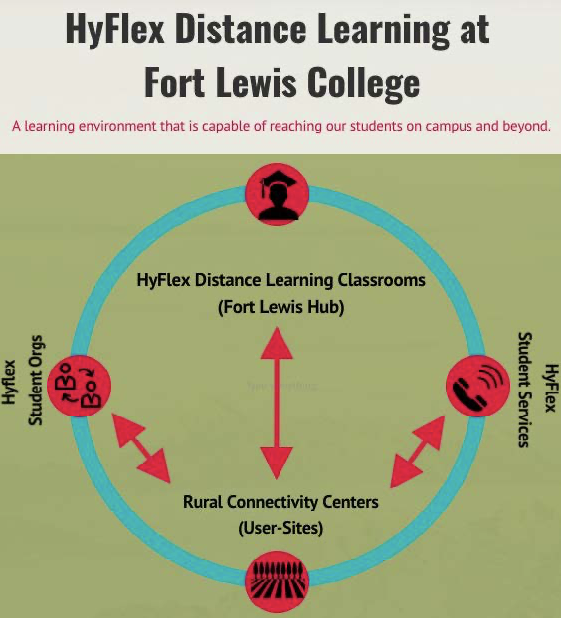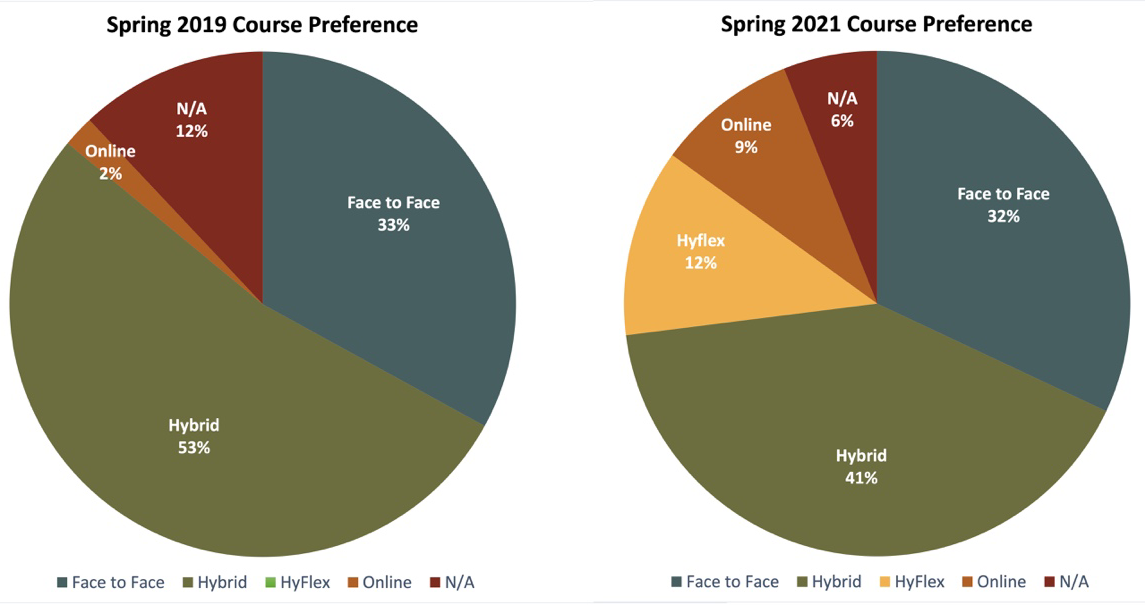Setting up HyFlex courses on any campus requires thoughtful planning, careful analysis, continual assessment, and faculty support. But is HyFlex something that higher education institutions can and should permanently adopt in a post-pandemic world?

COVID-19, super-spreader, social distancing, and elbow bumps: Amid the plethora of new vocabulary acquired from the pandemic, the term HyFlex emerged. This teaching and learning model has staying power—enough to disrupt and potentially improve higher education for years to come. As vaccines continue to be distributed and we in the higher education community return to something that resembles what we recall as "normal" in the upcoming academic year, the question remains: Is HyFlex something that higher education institutions can and should permanently adopt to serve students?
During the pivot to online instruction, many institutions saw the HyFlex (hybrid-flexible) course delivery model as a way to reach both students who wanted to learn on campus and students who needed remote or online access due to quarantine requirements or because they felt more comfortable remaining at home while continuing their degree. However, implementing HyFlex is no small feat. It requires a series of specific actions to be taken at an institutional level, from the initial phase of defining HyFlex to supporting faculty and students in course design and delivery. More specifically, the process involves defining HyFlex to meet the unique needs of students and faculty at your institution, designing successful HyFlex courses using Brian Beatty's four fundamental values of hybrid-flexible design,Footnote1 and prioritizing steps to scale the HyFlex delivery model for the needs of your campus. Classroom technology also plays a key role in successful HyFlex implementation, including hardware setup, technical use and cost, pedagogical use of technology tools, and faculty training and support. Finally, student voices are a vital component in the success of HyFlex. Gleaning students' insights on the efficacy of HyFlex courses and gauging their satisfaction with the delivery model is essential for success.
Designing HyFlex for the Unique Learning Environment at Fort Lewis College
Fort Lewis College (FLC), located in the southwest corner of Colorado, serves a diverse student body that is defined by its rural, multiethnic composition. As a federally designated Native American-serving institution, FLC has a historic commitment to Native American students that spans more than one hundred years. In June 2020, US News and World Report named FLC the tenth most diverse liberal arts college in the nation. Currently, 41 percent of FLC students are Native American and 12 percent are LatinX. Roughly one-third of our students are the first in their family to go to college. Our students represent more than 177 Native American tribal nations and Alaskan Native villages, and nearly all of these students come from rural communities. The rich diversity of our student body contributes to the unique learning environment at FLC; however, serving the educational needs of such a diverse rural student population also presents unmet challenges.
One of the most prominent educational barriers is the digital divide. While FLC was aware of this hurdle prior to the coronavirus pandemic, the impacts of the digital divide on equitable student learning and student access have become more apparent since the pandemic began. Flexible course delivery is particularly important on the FLC campus because many of our students commute to campus from rural communities every day, and our Native American students frequently attend Indigenous ceremonies that are integral to their tribal membership. With its reputation for being the most flexible instructional delivery model in the distance education space, HyFlex was a good fit for the range of needs that FLC faced during the pandemic. A HyFlex course allows students the flexibility to choose their preferred method of learning; they can attend some sessions online and other sessions in the classroom based on their individual preferences, needs, or immediate circumstances. However, as a rural, Indigenous-serving, non-tribal college, FLC had embraced HyFlex as a no-cost solution to serving diverse students with varying attendance needs even before the pandemic.

Determining If HyFlex Is the Right Fit for Your Institution
The following checklist can help you decide if adopting a HyFlex teaching and learning model would be appropriate at your campus, determine how HyFlex might fit as a long-term course offering, and understand what is needed to get HyFlex successfully off the ground.
Align HyFlex with the Institutional Mission, and Make Sure It Is Faculty-Driven
Consider ways to ensure faculty buy-in for HyFlex when launching it at your institution.
The FLC campus mission statement says that "students are at the center of Fort Lewis College, where we create inclusive, experiential learning environments that foster innovation, growth, and community engagement." Thus, distance education growth at FLC has always been faculty led and driven, representing the needs of our diverse student body. While Academic Affairs leadership supports distance education growth through the strategic plan and the prioritization of courses and programs, the decision, time, and commitment ultimately reside with the faculty body.
HyFlex was introduced to the FLC faculty senate in early spring 2020 for their approval to formally add it to the institutional course delivery types. Some faculty questioned the lack of evidence that HyFlex would be a good fit for FLC. Given that this discussion happened before the pandemic, it wasn't a surprise that HyFlex was met with some level of skepticism. As a proof of concept, FLC conducted a pilot, offering several HyFlex classes before formally adopting the model.

Design a Pilot
Consider ways to create an opportunity to experiment with, test, and assess the HyFlex delivery model with faculty and students.
Ten faculty members participated in the pilot program and offered their course as HyFlex during the fall 2020 term, advantageously timed in the midst of the coronavirus pandemic. The pilot was collaborative: the provost agreed to offer a stipend to faculty members who piloted their courses, the IT department worked over the summer to equip two classrooms with HyFlex technology, and other stakeholders on campus provided input throughout the process. The office of Teaching and Learning Services held a series of meetings with faculty pilots prior to the start of the term for them to learn about HyFlex, discuss tips for designing and structuring HyFlex courses, and share ideas and resources. These meetings helped ensure that the faculty pilots felt prepared, especially because formal HyFlex training did not exist at the time. A Canvas course was created to curate resources, articles, syllabus templates, and anything else HyFlex-related. Several meetings were also held to create a campus-wide definition of HyFlex to add to the institution's distance education policy and to draft a HyFlex guidebook for faculty, based on Brian Beatty's open-source book Hybrid-Flexible Course Design.
Create a Campus-Wide Definition
Consider how your definition will maintain the integrity of the HyFlex model while being unique to your institutional needs.
Creating the definition was the most complex part of the pilot. We wanted to ensure that it was crafted in a way that offered autonomy to faculty in how they designed their courses (either synchronously or asynchronously) and made student flexibility non-negotiable. The definition was revised several times after it was vetted by the campus learning team, the teaching and learning committee, and faculty senate. Finally, we decided on the following definition:
Courses delivered with fully remote option(s)—synchronous or asynchronous—along with regularly scheduled in-person classes, allowing students to transition seamlessly between the two learning environments.
Leverage Technology Infrastructure, Access, and Training for Successful HyFlex Delivery
Faculty Support
Consider how your faculty will be trained to successfully design and deliver a HyFlex course.
For the design and delivery of the pilot courses, we relied heavily on Beatty's four principles of HyFlex course design: learner choice, equivalency, reusability, and accessibility.Footnote2 To address these principles with future HyFlex course developers, we designed a two-week module within our existing faculty training course for online instructors. In that module, faculty adapt their existing course map to indicate the assessments that students will complete in each modality (synchronous and asynchronous) to show mastery of the course outcomes. This exercise helps faculty think through the variances in assessments depending on the pathway. In addition, this two-week module for HyFlex instructors allows faculty to explore how their course outcomes can be met and assessed in each learning mode, create a plan for providing content in each mode, explore engagement strategies for online and in-person learners, and identify any major implementation factors (such as required materials for a lab). Going forward, HyFlex training will be carried out collaboratively between Teaching and Learning Services and two faculty mentors; each mentor will receive one course release per semester of service. Faculty mentors will plan and deliver HyFlex workshops each semester and will be on call to provide guidance to their colleagues as they integrate the HyFlex model into their own classrooms.
Technology Considerations
Consider the technology infrastructure needed in designated HyFlex classrooms for your faculty and students to be successful in each instructional mode.
Three distinct demands guided our considerations for technology: nimble and high-quality classroom infrastructure, easy student access, and focused faculty training. To successfully meet these demands, we partnered with our IT department to apply for a $950,060 grant from the US Department of Agriculture. This grant provides funding to establish four rural connectivity centers in nearby communities. "Insufficient access to Wi-Fi and not being able to find a dependable cell service connection to the internet hampers a student's ability to learn. The funding provided will create accessible, virtual classrooms for rural students at Fort Lewis College regardless of their location and allow them to remain connected to campus, their classmates, and the student services available," said acting Colorado Rural Development State Director Irene Etsitty. A large portion of the grant will outfit FLC classrooms with new technology to enable the successful delivery of HyFlex courses, including equipping them with video teleconferencing software capability, multiple screens with touch screen capabilities and interactive functionality, tracking cameras, microphones, and audio. The Tomorrow Room on campus is a space where new technology will be showcased so that faculty can become familiar with the room design and technology before teaching in a HyFlex classroom.
The Digital Bridge
Consider strategies to incorporate HyFlex technology for increased connections.
The FLC strategic HyFlex plan includes a two-step technology implementation. First, beginning in fall 2021, to participate in their declared major, all incoming first-year students will be required to either own a laptop that meets certain minimum specifications or rent one from the FLC IT department. This is part of a permanent transition to a one-to-one device campus. The FLC TechPack initiative provides students with the hardware, software, and support needed to be successful academically. Second, to facilitate the design of courses intended for rural virtual learners, FLC will incorporate HyFlex technology into classrooms and student services offices across campus. The pandemic has accelerated our efforts to equip each classroom with video teleconferencing technology; however, the USDA grant will allow the institution to enhance its technology infrastructure to create high-quality experiences for instructors and learners. Over the course of the three-year grant, thirty-two classroom spaces—equating to 33 percent of our campus learning spaces—and eight student services spaces will be equipped with technology that will enable remote access. Multiple screens will permit rural students to appear as similarly as possible to local participants, thus facilitating student-to-student and student-to-faculty connections. Tracking cameras will improve content delivery so that remote students will feel as if they are actually in the classroom, and high-quality microphones will complete the experience by allowing students and faculty to engage seamlessly.

Evaluate Student Success and Student Demand
Consider curating student success data and amplifying student voices.
A multi-semester analysis (spring 2019—fall 2020) of grades for eleven HyFlex courses (fall 2020 with one course from fall 2019) suggests that students receive lower D, F, and withdrawal (DFW) rates in HyFlex courses by approximately 9 percent compared to the same course taught by the same instructor using other teaching modalities (face-to-face, online, and hybrid). In other words, students appear to pass HyFlex courses at slightly higher rates than all the other modalities combined. Grades of A, B, and C were stable across HyFlex and other learning modalities. One Spanish language course seemed to be an anomaly, with a higher percentage of students passing in the face-to-face modality than in the HyFlex modality. Grades from spring 2021 HyFlex courses demonstrated the importance of faculty training, with slightly higher DFW rates in HyFlex courses taught by faculty who had not undergone professional development in distance education. HyFlex STEM courses had the highest DFW rates in spring 2021. While this may seem alarming, it's important not to get discouraged by data when embarking on a new teaching modality such as HyFlex. The purpose of learning analytics like DFW rates is to uncover gaps and work to address them. Future professional development for HyFlex instruction may include a section dedicated to teaching STEM courses and conducting labs.
Qualitative data from student evaluations were gathered to help us understand the impacts of HyFlex for our unique student population. Following are some representative quotes from the student evaluations:
- "The HyFlex course is awesome!"
- "The HyFlex course takes some stress away."
- "Offering an online or in-class option" helped make the learning experience better.
- "I never did any of the online components, but I did appreciate the option to do so."
- "I really liked being able to go to class but to also do it online if I could not make it that day."
- "The online component was great, and I often liked the online videos more because they were interesting, and I liked taking my time to put in my personal thought."
- "The HyFlex course is great. It is nice to have the option to go to class."
- "The HyFlex class was exactly what I needed this semester. It gave me the opportunity to learn on my own. The organization and the content helped me learn and [remain] interested."
- "I knew exactly what was expected from me at the very beginning and knew what each day would entail. I decided to take this course entirely asynchronously, and I was never confused or worried about what I needed to turn in."
- "The online lecture videos and Canvas discussions are just as helpful and informative as the ones we have in person."
We also wanted to see if students were enrolling in HyFlex courses at a higher rate than they were enrolling in other course modalities. An analysis of course enrollments always presents challenges due to fluctuating course cap numbers, the number of sections offered per term, etc. Overall, course enrollment in the twenty-six HyFlex courses offered in spring 2021 compared to enrollment in HyFlex courses from the previous term (fall 2020) did not reveal any consistent patterns. Some HyFlex courses had higher enrollments than their fall 2020 counterparts, suggesting a potential need for increased course caps in HyFlex courses.

In fall 2021, FLC has twenty-four courses scheduled for HyFlex delivery, specifically undergraduate courses for our exercise science bachelor's degree program and graduate courses for our teacher education master's degree programs. Beginning in fall 2021, we will be conducting a more robust research project to evaluate the success of our HyFlex course offerings. The following questions will be part of a larger student survey:Footnote3
- Given the opportunity to participate in various modalities, will student preferences for different modalities change?
- When given the opportunity to participate in HyFlex, will students blend the modalities to suit their needs? That is, what will be the reasons that students pick one mode over another?
- When given a choice of modality, which format do students select?
- What benefits and challenges did students experience with each modality?
- What are students' overall attitudes toward HyFlex?
- Do students feel that the rigor and quality of the different modalities are comparable?
Conclusion
Perfecting HyFlex instruction will take time, and FLC is committed to this modality as a long-term project. We will continue to learn from our peer institutions about the successes and challenges of implementing HyFlex. Setting up HyFlex on any campus requires thoughtful planning, careful analysis, continual assessment, and faculty support. Is it worth it? Our students seem to think so, and for that reason alone, it is a worthwhile endeavor for us to get it right.Footnote4
Notes
- Brian J. Beatty, Hybrid-Flexible Course Design: Implementing Student-Directed Hybrid Classes, (EdTech Books, 2019). Jump back to footnote 1 in the text.
- Ibid. Jump back to footnote 2 in the text.
- Robert Talbert, "Research Report: Experiencing the HyFlex Model," Robert Talbert, PhD (website), May 8, 2020. Jump back to footnote 3 in the text.
- A portion of the content for this article was retrieved from Fort Lewis College's grant application to the USDA. Attribution is given to the grant team for their work: Ben Waddell (PI), Patrick Gaughan, Lee Bitsui, Lorien Chambers-Schuldt, Tapati Dutta, and Jennifer Rider. Additional information and resources about FLC's HyFlex work and grant award can be found on the FLC home page; the FLC TechPack web page; the US Department of Agriculture Rural Development website; Diana Castillo, "Fort Lewis College Plans to Use Grant to Improve Distance Learning," KOB 4 (website), March 8, 2021; and Mike Easterling, "USDA Grant Will Help FLC Open Distance Learning Centers in Shiprock & Window Rock" [https://www.daily-times.com/story/news/local/2021/03/08/usda-grant-1-million-facilitate-distance-learning-fort-lewis-college/4603236001/], Farmington Daily Times, March 8, 2021. Jump back to footnote 4 in the text.
Jennifer Rider is the Director of Teaching and Learning Services at Fort Lewis College.
Ayla Moore is the Instructional Designer at Fort Lewis College.
© 2021 Jennifer Rider and Ayla Moore. The text of this work is licensed under a Creative Commons BY 4.0 International License.
